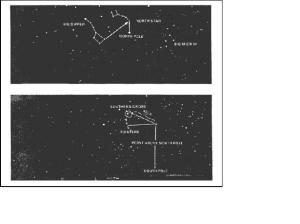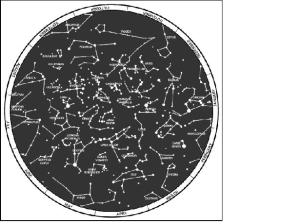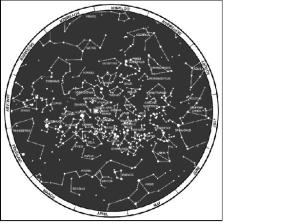CONSTELLATIONS
what is constellation?
--a group of stars forming a recognizable pattern that is traditionally named after its apparent form or identified with a mythological figure.
Ursa Major, the Great Bear

Of all the star patterns in the sky, the Big Dipper is the most universally recognized. The dipper's seven bright stars form a portion of the great bear. It's hard to see the rest of the bear, especially from light-polluted cities.
After you locate the dipper, look at the two stars that mark the outer edge of its bowl. Now connect these two stars, then extend the line above the dipper's bowl. Polaris, the north star, lies along this line, about five times the distance between the two pointers. No matter where the Big Dipper is in our sky, those two stars always point to Polaris. A MAJOR
Orion is a prominent set of stars visible during winter in the northern celestial hemisphere. It is one of the 88 modern constellations; it was among the 48 constellations listed by the 2nd-century astronomer Ptolemy. It is named for a hunter in Greek mythology.
Orion is most prominent during winter evenings in the Northern Hemisphere, as are five other constellations that have stars in the Winter Hexagon asterism. Orion's two brightest stars, Rigel (β) and Betelgeuse (α), are both among the brightest stars in the night sky; both are supergiants and slightly variable. There are a further six stars brighter than magnitude 3.0, including three making the short straight line of the Orion's Belt asterism. Orion also hosts the Orionids, the strongest meteor shower associated with Halley's Comet, and the Orion Nebula, one of the brightest nebula in the sky.
Characteristics

FINDING NORTH BY CONSTELLATIONS
Star Method.
(1) Less than 60 of approximately 5,000 stars visible to the eye are used by navigators. The stars seen as we look up at the sky at night are not evenly scattered across the whole sky. Instead they are in groups called constellations.
(2) The constellations that we see depends partly on where we are located on the earth, the time of the year, and the time of the night. The night changes with the seasons because of the journey of the earth around the sun, and it also changes from hour to hour because the turning of the earth makes some constellations seem to travel in a circle. But there is one star that is in almost exactly the same place in the sky all night long every night. It is the North Star, also known as the Polar Star or Polaris.
(3) The North Star is less than 1° off true north and does not move from its place because the axis of the earth is pointed toward it. The North Star is in the group of stars called the Little Dipper. It is the last star in the handle of the dipper. There are two stars in the Big Dipper, which are a big help when trying to find the North Star. They are called the Pointers, and an imaginary line drawn through them five times their distance points to the North Star. There are many stars brighter than the North Star, but none is more important because of its location. However, the North Star can only be seen in the northern hemisphere so it cannot serve as a guide south of the equator. The farther one goes north, the higher the North Star is in the sky, and above latitude 70°, it is too high in the sky to be useful (Figure 9-9).
Figure 9-9. Determining direction by the North Star and Southern Cross.
(4) Depending on the star selected for navigation, azimuth checks are necessary. A star near the north horizon serves for about half an hour. When moving south, azimuth checks should be made every 15 minutes. When traveling east or west, the difficulty of staying on azimuth is caused more by the likelihood of the star climbing too high in the sky or losing itself behind the western horizon than it is by the star changing direction angle. When this happens, it is necessary to change to another guide star. The Southern Cross is the main constellation used as a guide south of the equator, and the above general directions for using north and south stars are reversed. When navigating using the stars as guides, the user must know the different constellation shapes and their locations throughout the world (Figure 9-10 and Figure 9-11).
Figure 9-10. Constellations, northern hemisphere.
Figure 9-11. Constellations, southern hemisphere.
FIGURE 9.11




Comments
Post a Comment